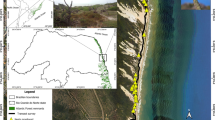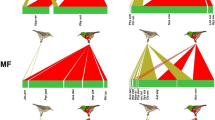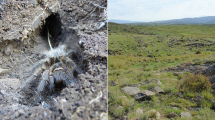Abstract
Plovers (subfamily: Charadriinae) are visual foragers that rely on ambient light for detection of invertebrates, as demonstrated by their foot-stirring behaviour used to stimulate a flight response in prey. At night, although ambient light is minimal, predation pressure from diurnal raptors is reduced and invertebrate prey availability increases, thus creating fitness benefits to nocturnal foraging by invertivores. The Killdeer (Charadrius vociferus) is a widespread yet understudied Plover that primarily inhabits agricultural fields throughout North America during the winter. Because nocturnal ambient light is directly dependent upon the lunar cycle, I hypothesized that Killdeer exploit nights with greater lunar illumination to be able to forage when predation risk is low and prey availability is enhanced. I predicted that nocturnal activities by Killdeer would be reflected in their diurnal behaviour the subsequent day, with decreased diurnal foraging following lighter nights. I also considered the additive effect of lower ambient temperatures and precipitation. I used an information-theoretic framework to compare these hypotheses and found the model with greatest support revealed a clear negative relationship between diurnal foraging and the amount of lunar illumination the preceding night. Interestingly, I found the opposite trend in diurnal roosting behaviour, suggesting that if nocturnal light levels suffice, Killdeer forage at night and roost during the day. I propose that this behaviour is driven by differential predation risk and food availability perceived by Killdeer at night vs. day. I also discuss the potential functional importance of energetic demands. Taken together, these results highlight the potential for avian diurnal behaviour to be closely tied to natural variation in nocturnal light availability, a finding with potential relevance to the increasing threat of artificial light pollution in our era of industrialization.
Zusammenfassung
Tanzen im Mondlicht: Keilschwanz-Regenpfeifer variieren ihr Nahrungssuchverhalten mit dem Mondzyklus
Regenpfeifer (Unterfamilie: Charadriinae) sind visuelle Nahrungssucher. Sie sind deshalb auf Licht angewiesen, um ihre Beute zu detektieren, was man an ihrem “Trampel”-Verhalten sieht, das sie einsetzen, um Invertebraten aufzuscheuchen. Nachts ist zwar die Lichtintensität niedrig, aber die Gefährdung durch tagaktive Räuber ist gering und die Verfügbarkeit von Beute ist höher. Für Räuber, die Invertebraten jagen, bringt das Fitnessvorteile mit sich. Der Keilschwanz-Regenpfeifer (Charadrius vociferus) ist ein weit verbreiteter, wenig erforschter Regenpfeifer, der in Nord-Amerika während des Winters vorwiegend landwirtschaftliche Flächen nutzt. Da die nächtliche Lichtintensität direkt mit dem Mondzyklus zusammenhängt, prüfte ich die Hypothese, ob Keilschwanz Regenpfeifer Nächte mit mehr Mondlicht, in denen das Räuberrisiko geringer und die Beuteverfügbarkeit höher ist, zur Nahrungssuche nutzen. Meine Hypothese war, dass sich die nächtliche Aktivität der Regenpfeifer in ihrem Verhalten am nachfolgenden Tag bemerkbar machen sollte, indem sie an Tagen, die auf Nächte mit hellem Mondlicht folgen, ihr Nahrungssuchverhalten reduzieren. Dabei berücksichtigte ich auch die Effekte von Regenfall und niedriger Umgebungstemperatur. Ich nutzte ein informationstheoretisches Modell, um diese Hypothese zu prüfen. Das am besten unterstützte Modell zeigt einen deutlich negativen Zusammenhang zwischen Nahrungssuche am Tag und der Mondlichtintensität der vorangehenden Nacht. Interessanterweise zeigte sich der entgegengesetzte Trend in der Ruhezeit am Tage. Das legt die Annahme nahe, dass Keilschwanz-Regenpfeifer bei ausreichender Lichtintensität während der Nacht Nahrung suchen und tagsüber vermehrt ruhen. Dieses Verhalten ist anscheinend verursacht durch die Unterschiede im Räuberrisiko bzw. der Nahrungsverfügbarkeit bei Tag gegenüber nachts. Zusammen genommen weisen die Befunde auf die Bedeutung nächtlicher Lichtintensität für die Tagaktivität von Vögeln hin. Diese Studie ist potentiell wichtig für die Beurteilung der zunehmenden anthropogenen nächtlichen Lichtverschmutzung.



Similar content being viewed by others
References
Altmann J (1974) Observational study of behavior: sampling methods. Behaviour 49:227–266
Bates D, Maechler M, Bolker B, Walker S (2015) Fitting linear mixed-effects models using lme4. J Stat Softw 67:1–48
Bring J (1994) How to standardize regression coefficients. Am Stat 48:209–213
Brown JS, Kotler BP (2004) Hazardous duty pay and the foraging cost of predation. Ecol Lett 7:999–1014
Brunton DH (1988a) Energy expenditure in reproductive effort of male and female Killdeer (Charadrius vociferus). Auk 105:553–564
Brunton DH (1988b) Sexual differences in reproductive effort: time-activity budgets of monogamous Killdeer, Charadrius vociferus. Anim Behav 36:705–717
Brunton DH (1990) The effects of nesting stage, sex, and type of predator on parental defense by Killdeer (Charadrius vociferous): testing models of avian parental defense. Behav Ecol Sociobiol 26:181–190
Burnham KP, Anderson DR (2002) Model selection and multimodel inference: a practical information-theoretic approach, 2nd edn. Springer, New York
Cerri RD, Fraser DF (1983) Predation and risk in foraging Minnows: balancing conflicting demands. Am Nat 121:552–561
Colwell MA (2010) Shorebird ecology, conservation, and management. University of California Press, Berkeley
Colwell MA, Dodd SL (1995) Waterbird communities and habitat relationships in coastal pastures of northern California. Conserv Biol 9:827–834
Colwell MA, Dodd SL (1997) Environmental and habitat correlates of pasture use by nonbreeding shorebirds. Condor 99:337–344
Conklin JR, Colwell MA (2007) Interaction of predators and manmade object causes potentially significant mortality in a wintering shorebird population. Wader Study Group Bull 112:57–59
Covich AP (1976) Analyzing shapes of foraging areas: some ecological and economic theories. Annu Rev Ecol Syst 7:235–257
Davies TW, Bennie J, Inger R, Gaston KJ (2013) Artificial light alters natural regimes of night-time sky brightness. Sci Rep. doi:10.1038/srep01722
Dodd SL, Colwell MA (1996) Seasonal variation in diurnal and nocturnal distributions of nonbreeding shorebirds at north Humboldt Bay, California. Condor 98:196–207
Dunk JR, Cooper RJ (1994) Territory-size regulation in Black-Shouldered Kites. Auk 111:588–595
Dwyer RG, Bearhop S, Campbell HA, Bryant DM (2013) Shedding light on light: benefits of anthropogenic illumination to a nocturnally foraging shorebird. J Anim Ecol 82:478–485
Edwards CA, Bohlen PJ (1996) Biology and ecology of earthworms. Chapman and Hall, London
Elder WH (1954) The oil gland of birds. Wilson Bull 66:6–31
Gillings S, Fuller RJ, Sutherland WJ (2005) Diurnal studies do not predict nocturnal habitat choice and site selection of European Golden-Plovers (Pluvialis apricaria) and Northern Lapwings (Vanellus vanellus). Auk 122:1249–1260
Johnson MD, Horn CM (2008) Effects of rotational grazing on rodents and raptors in a coastal grassland. West N Am Nat 68:444–452
Joyner JW, Harmon NP (1961) Burrows and oscillative behavior therein of Lumbricus terrestris. Proc Indiana Acad Sci 71:378–384
Krebs JR (1980) Optimal foraging, predation risk and territory defense. Ardea 68:83–90
Lane SJ, Hassall M (1996) Nocturnal feeding by Dark-bellied Brent Geese Branta bernicla bernicla. Ibis 138:291–297
Leeman TS, Colwell MA (2005) Coastal pasture use by Long-billed Curlews at the northern extent of their non-breeding range. J Field Ornithol 76:33–39
Lima SL (1988) Initiation and termination of daily feeding in Dark-eyed Juncos: influences of predation risk and energy reserves. Oikos 53:3–11
Long LL, Ralph CJ (2001) Dynamics of habitat use by shorebirds in estuarine and agricultural habitats in northwestern California. Wilson Bull 113:41–52
Lourenço PM, Silva A, Santos CD, Miranda AC, Granadeiro JP, Palmeirim JM (2008) The energetic importance of night foraging for waders wintering in a temperate estuary. Acta Oecol 34:122–129
Luff ML (1978) Diel activity patterns of some field Carabidae. Ecol Entomol 3:53–62
Martin GR, Piersma T (2009) Vision and touch in relation to foraging and predator detection: insightful contrasts between a Plover and a Sandpiper. Proc R Soc Lond B: Biol Sci 276:437–445
McNamara J, Ekman J, Houston AI (2004) The effect of thermoregulatory substitution on optimal energy reserves of small birds in winter. Oikos 105:192–196
McNeil R, Drapeau P, Goss-Custard JD (1992) The occurrence and adaptive significance of nocturnal habits in waterfowl. Biol Rev 67:381–419
McNeil R, Rojas LM, Marin G, Figueroa YMR (2004) Nocturnal activity and vision in Neotropical shorebirds. Ornitol Neotrop 15:223–232
Metcalfe NB, Furness RW (1984) Changing priorities: the effect of pre-migratory fattening on the trade-off between foraging and vigilance. Behav Ecol Sociobiol 15:203–206
Milsom TP, Rochard JBA, Poole SJ (1990) Activity patterns of Lapwings Vanellus vanellus in relation to the lunar cycle. Ornis Scand 21:147–156
Mouritsen KN (1992) Predator avoidance in night-feeding Dunlins Calidris alpina: a matter of concealment. Ornis Scand 23:195–198
Nakagawa S, Schielzeth H (2013) A general and simple method for obtaining R 2 from generalized linear mixed-effects models. Methods Ecol Evol 4:133–142
NOAA (2010) National Weather Service Forecast Office. Daily meteorological data for Arcata, California. http://www.wrh.noaa.gov/mesowest/getobext.php?wfo=ekaandnum=48andsid=kacv. Accessed 5 February 2010
Nol E, Lambert A (1984) Comparison of Killdeer, Charadrius vociferous, breeding in mainland and peninsula sites in southern Ontario. Can Field-Nat 98:7–11
O’Brien M, Crossley R, Karlson K (2006) The shorebird guide. Houghton Mifflin, New York
Page G, Whitacre DF (1975) Raptor predation on wintering shorebirds. Condor 77:73–83
Penteriani V, Kuparinen A, del Mar Delgado M, Lourenço R, Campioni L (2011) Individual status, foraging effort and need for conspicuousness shape behavioural responses of a predator to moon phases. Anim Behav 82:413–420
Pienkowski MW (1983) Changes in the foraging pattern of Plovers in relation to environmental factors. Anim Behav 31:244–264
Piersma T, Gill RE Jr, de Goeij P, Dekinga A, Shepherd ML, Ruthrauff D, Tibbitts L (2006) Shorebird avoidance of nearshore feeding and roosting areas at night correlates with presence of a nocturnal avian predator. Wader Study Group Bull 109:73–76
Plissner JH, Oring LW, Haig SM (2000) Space use of Killdeer at a Great Basin breeding area. J Wildl Manage 64:421–429
R Development Core Team (2015) R: a language and environment for statistical computing. R foundation for Statistical Computing, Vienna
Rand AL (1956) Foot-stirring as a feeding habit of Wood Ibis and other birds. Am Midl Nat 55:96–100
Robert M, McNeil R (1989) Comparative day and night feeding strategies of shorebird species in a tropical environment. Ibis 131:69–79
Rojas LM, McNeil R, Cabana T, Lachapelle P (1999) Diurnal and nocturnal visual capabilities in shorebirds as a function of their feeding strategies. Brain Behav Evol 53:29–43
Santos CD, Miranda AC, Granadeiro JP, Lourenço PM, Saraiva S, Palmeirim JM (2010) Effects of artificial illumination on the nocturnal foraging of waders. Acta Oecol 36:166–172
Sanzenbacher PM, Haig SM (2001) Killdeer population trends in North America. J Field Ornithol 72:160–169
Sanzenbacher PM, Haig SM (2002) Regional fidelity and movement patterns of wintering Killdeer in an agricultural landscape. Waterbirds 25:16–25
Sauer JR, Hines JE, Fallon J (2005) The North American Breeding Bird Survey, Results and analysis 1966–2004. Version 2005.2. USGS Patuxent Wildlife Research Center, Laurel, MD. http://www.mbr-pwrc.usgs.gov/bbs/bbs.html. Accessed 4 February 2010
Sibley DA (2001) The Sibley guide to bird life and behavior. Knopf, New York
Slessers M (1970) Bathing behavior of land birds. Auk 87:91–99
Smith PC, Evans PR (1973) Studies of shorebirds at Lindisfarne, Northumberland. 1. Feeding ecology and behaviour of the Bar-tailed Godwit. Wildfowl 24:135–140
Smith KW, Reed JM, Trevis BE (1999) Nocturnal and diurnal activity patterns and roosting sites of Green Sandpipers Tringa ochropus wintering in southern England. Ringing Migr 19:315–322
Stauffer HB (2007) Contemporary Bayesian and frequentist statistical research methods for natural resource scientists. Wiley, Hoboken
USNO (2010) Astronomical Applications Department. Sun and moon data for Arcata, California. http://aa.usno.navy.mil/data/docs/RS_OneDay.php. Accessed 5 February 2010
Warnock N, Oring LW (1996) Nocturnal nest attendance of Killdeers: more than meets the eye. Auk 113:502–504
Acknowledgments
I thank S. Cornberg of the Sun Valley Group for allowing me access to the focal pasture, R. Ruehl of NOAA for access to and interpretation of meteorological data, and A. Desch of the Humboldt State University Wildlife Department stockroom for lending the necessary equipment for data collection. I am grateful for statistical guidance from M. Galipaud, H. Schielzeth, T. Schmoll, H. Stauffer, R. Van Kirk, and the Stats Club of Bielefeld University’s Evolutionary Biology and Animal Behaviour Departments. I thank E. Humble and M. Stoffel for assistance with writing the supplemental Rmarkdown document and setting up the GitHub repository. I also thank L. George for helpful comments about my study design, P. Korsten and F. Trillmich for engaging discussions on the topic, N. Warnock and two anonymous reviewers for constructive comments, M. Colwell who equipped me with his inspirational insight into shorebird ecology, and J. Dierks for her endearing support.
Author information
Authors and Affiliations
Corresponding author
Additional information
Communicated by F. Bairlein.
Electronic supplementary material
Below is the link to the electronic supplementary material.
10336_2016_1389_MOESM1_ESM.pdf
Appendix A: RMarkdown PDF file containing all computer code and documentation to reproduce all analyses presented in the paper. Appendix B: Three datasets containing the raw behavioural, meteorological, and lunar data used in all analyses. (PDF 268 kb)
Rights and permissions
About this article
Cite this article
Eberhart-Phillips, L.J. Dancing in the moonlight: evidence that Killdeer foraging behaviour varies with the lunar cycle. J Ornithol 158, 253–262 (2017). https://doi.org/10.1007/s10336-016-1389-4
Received:
Revised:
Accepted:
Published:
Issue Date:
DOI: https://doi.org/10.1007/s10336-016-1389-4




